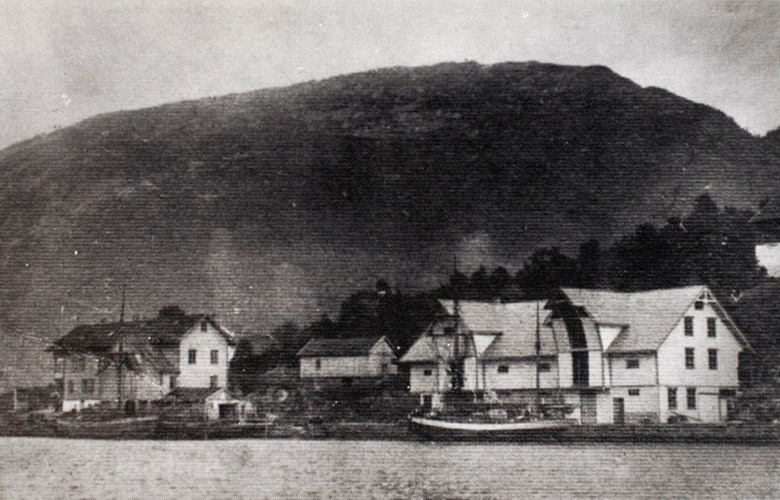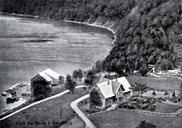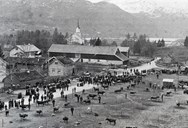The municipality of Førde in 1905
In 1900 the population of the municipality of Førde numbered 2913. The municipal boundaries were much as they are today, while Førde Parish then included Førde, Holsen (with Haukedal chapel), Naustdal, and Vevring. The municipality bordered on the municipalities of Naustdal, Jølster, Balestrand, and Indre Holmedal (Gaular today). The municipality was also a bailiff district, and was the seat of a court. Mo jordbruksskule (school for agriculture and forestry) was located at Mo, but owned by the county. M. L. Storm was the principal there.
Agriculture was the main industry of Førde in 1905, but the 1900 census shows that one half of the farmers had income in addition to farming. There were eight dairies in Førde: at Fauske, Indre Angedalen, Nedre Angedalen, Sundsdalen, Vie, Holsen, Gjerland, and at Hårklau. Trade and commerce, service, and various crafts grew during this period. But since there were in all only 11 shopkeepers, it is safe to say that it was far from the present-day Førde, which is the trade and commercial centre of the county. Tourism was in its infancy as well. Salmon fishing in the river Jølstra lured tourists to Førde. The shipping company Fylkesbaatane stopped for passengers and goods at Ervik and at Steinen.
Førde "town" in 1905
The densest population was in the centre Førde with 648 inhabitants in 1900, and at the lower end of Angedalen. Førde was the name of the centre in the municipality, then as now. Yet the population of Førde "town" was rather scattered, with Steinen as an important traffic juncture with its wharf and stop for the Fylkesbaatane vessels. Because of the transport of goods at sea the wharf at Steinen was important for Førde and surrounding areas, even for the Jølster population. The activity at Steinen made the area Ytre Hafstad - Halbrend the centre of the community.
There was one bank in the municipality, ¿Førde Sparebank" (Savings Bank). Miss Thesen managed the only telegraph station and telephone exchange, and she was one of the very few independent salaried women at this time. There were two post offices, one at Førde and one at Holsen. The municipal treasurer A. Hafstad managed the post office at Førde. At Holsen Gjert M. Holsen, farmer, had that job. In 1905, as in 2005, there were two hotels. Miss Anna Hafstad managed Hafstad hotell, while the grocer Bernt Sivertsen managed Sivertsens hotell. The latter also managed the coaching station.
Roads and lake communications
In the neighbourhood of the lakes Movatnet, Åsavatnet, Holsavatnet, and Haukedalsvatnet, water was the inevitable means of transportation, both summer and winter. Rowboats in summer and horse and sledge or carriage in winter. The biggest boats, the "øykjabåt", were used to transport animals and materials, or used when the wind was too strong for the rowboats. These bigger boats were also used in connection with funerals and weddings.
Other issues and events
The dissolution of the union with Sweden was the all-important event all through the year 1905, but there were other issues as well. The New Norwegian language movement - the struggle for wider use of "nynorsk" ("New Norwegian", a written variant of Norwegian based less on Danish and more on Norwegian dialects) - had the strong support of many people. The emigration to America was also an important topic. The idea of a railway to Sogn was hotly debated. The Bergen Railway was being built, and in 1905 the long tunnel Gravhalstunnelen was finished. The health service was important for many, and in particular the building of a hospital at Lærdal.
The newspapers reported at all times about events big and small in the county, in the country, and the world at large - through short paragraphs and in more comprehensive articles. The newspaper Fjordenes Tidende reported that the organization "Fjordenes kreds af N. K. U. F" could celebrate its tenth anniversary and that many new associations had joined in the course of the winter and the spring. The newspaper Sogns Tidende reported that a comprehensive rebuilding of the Hafstad hotell was in progress ".., so this very beautifully situated hotel will present itself to the tourists of the coming summers in a considerably enlarged and beautified appearance". The fire at Ervik in 1905 made a great impression. According to the newspaper Fjordenes Tidende, the Ervik juice and syrup factory, the sawmill, the moulding and planing mill, the wharf, the post office, and the grocer's shop burnt down. The only drowning tragedy in the lake Holsenvatnet happened in this year. A flock of sheep ran out on the thin ice, which broke. In the efforts to save the sheep, a boat capsized, and a man drowned. People also talked about the terrible avalanche tragedy at Loen, which was reported as well in the nationwide press.
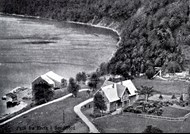
Some important individuals
There were local elections in 1904, and O. M. Erdal was elected mayor. J. E. Landmark was vicar. The curate of the parish, Ludvig O. Solheim, resided at Naustdal. Albert Marius Steen was bailiff. The magistrate for Sunnfjord, E. G. W. Moss, resided in Førde. The district physician for Indre Sunnfjord, Franz Willhelm Münster, likewise. And so did the county veterinarian Cato Leknes. Member of the Storting (Parliament) and Speaker of the Lagting (the smaller division of the Storting) Gjert Martiniusen Markvardson Holsen came from Holsen. (See article about Holsen). The music composer Johannes Haarklou came from Haukedalen. Nille Hafstad, née Fleten, was the midwife in Førde.
Associations and organizations
In the municipality of Førde there were a growing number of clubs and other organizations: a rifle club, friend of farmers association, several religious associations and missionary friends, and four youth clubs: Øvre Angedalen Ungdomslag, Nedre Angedalen Ungdomslag, Førde Ungdomslag og Holsen Kristelege (Christian) Ungdomslag. The agriculture industry was also represented in the great variety of organizations with Førde landboforening (Førde agricultural association) and Førde fjærkreforening (Førde poultry association).
Strife for freedom in the language struggle and the flag struggle were identical with the liberal-minded youth movement, and Nedre Angedalen ungdomslag (youth association) and the boys from Mo jordbruksskule (school for agriculture and forestry) took the lead in the struggle for the independent Norwegian flag when they on 17 May, 1895, marched into Førde with it.
17 May, 1905
The 17 May celebration in 1905 drew large crowds throughout the whole country. Next day the Storting was going to vote on the proposal for a separate Norwegian consular service. 17 May was therefore celebrated with great enthusiasm and gravity that year.
In Førde the day was celebrated with a church service and a children's procession. The newspaper Fjordenes Blad reported that the vicar and a teacher headed the procession with " ..17 May national song under the Norwegian flag, while the parish clerk sat at home complaining about the national madness. In the church hymns by Elias Blix were sung, and they were also suggested in the sermon..." There is no information about the parish clerk who is described so unfavourably, perhaps he was a unionist?
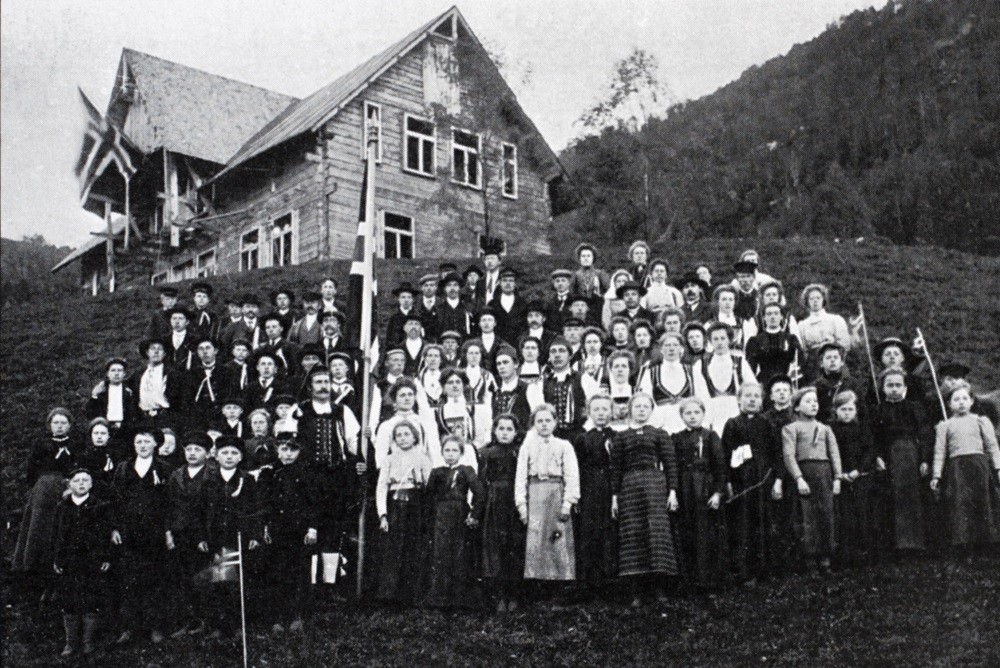
7 June, 1905
7 June 1905, the day on which the union with Sweden was dissolved, was a Wednesday and an ordinary working day, yet people waited in excite anticipation for the latest news from the capital and from the Storting. As the news came out, people hoisted their flags, and in some places they sent telegrams of greetings to the authorities. The Storting released an announcement about the dissolution of the union. The church ministry asked the vicars to read the announcement in the churches on Whitsunday , 11 June, or later.
The vicar of Førde has not registered anything about this service, but somewhere in the parish there must have been a Whitsunday church service, so the missing item in the register is most likely an oversight. Not all the vicars were conscientious as far as registering their activities in the "journal" was concerned. There were only a few days between the dissolution of the union and Whitsunday, and not all the vicars had received the announcement before the Whitsunday church service. Many vicars decided to recite a prayer for the country and read the announcement in the following Sunday service.
The referendums - the suffrage and election committee
There were two referendums in 1905:
The first was on Sunday, 13 August, when the people were asked to say yes or no to the dissolution of the union which had taken place on 7 June.
The second was on Sunday, 12 November and on Monday the 13th, when the people were asked to say yes or no to the coronation of a king. In reality this was a choice between monarchy and republic.
The Førde election district comprised the three municipalities of Førde, Naustdal, and Vevring. The election committee consisted of: the bailiff of Førde, Albert Steen (chairman), O. M. Erdal, L. Røyseth, O. Schei, O. Eikeland, R. Gjerland, Olai Horstad, G. B. Thune, S. E. Horstad, R. Grimeland, A. G. Hegrenes, G. M . Olsen, Andr. Vefring, L. Botnen, Anders Sæle, L. T. Farsund.
Polling stations
The election board decided where the votes could be cast, and who could vote where. There were four polling stations: in the church in Førde, in the church at Holsen, in the church at Naustdal (in the administration building of Naustdal municipality on 13 November), in the school house at Vevring in August, while the people there voted in the church on 12 November and on the 13th.
The counting of votes took place in the premises of the municipal administration of Førde after both referendums.
The referendum in August - yes or no to the dissolution of the union
13 August was a celebration and a solemn occasion. In many places it was like the 17 May celebrations, with a church service, speeches, flags, processions, and fun. Yet people's main attention was on the voting. As in the Førde parish the churches were used as polling stations, and the vicars were clearly instructed to act in such a way that the voting was not obstructed. The circular from the church ministry stated that in the event that the church was used as polling station, the normal church service schedule should be adhered to. It seems that the parsons in Førde parish gave the normal church service schedule priority, and in consequence there was a service at Naustdal on this day. The records are unclear, and only this service has been registered for this Sunday.
The result of the referendum in the Førde constituency: 1308 men had the right to vote. 1166 valid votes were cast. All voted yes. The turnout was 89.4%.
The result for the county of Sogn og Fjordane: 16,819 had the vote. 16,718 (88.7 %) valid votes were cast. Only three voted no.
The result for the whole country: 435,376 had the vote, 368,392 valid votes were cast, 368,208 voted yes, 184 voted no.
Private petition by women
Women did not have the suffrage in 1905. But the women wanted to say their yes along with the men. Several women's organizations joined forces in a countrywide petition, and on 22 August they handed over more than 250,000 signatures to the Storting.
The collection of signatures was organized in different ways. Lists were laid out in newspaper offices, in shops, and were passed from house to house. The women had only a few weeks, so time was short. They made use of the connections they had, and with the broad scope of the initiative there were many possible recipients, women and men, liberals, teachers, language activists, public servants, etc.. Førde should therefore have many potential recipients. Yet no such lists from Førde have been found, but such lists could still have been in circulation.
The referendum in November - monarchy or republic
The result of the referendum in November for the Førde constituency: 1301 had the right to vote. 1078 men voted, seven votes were invalid. Of the valid votes, 981 were yes (for monarchy), 90 voted no (for republic).
The result for the county of Sogn og Fjordane: 18,278 had the vote, 14,315 (78.3 %) valid votes were cast. 11,507 voted for monarchy, 2808 for republic.
The result for the country: 331,833 had the vote, 244,124 valid votes were cast (73.5%). 194,189 (79.5%) voted for monarchy, 49,935 (20.5%) for republic.
The new royal family
On 18 November the Storting chose Prins Carl of Denmark King of Norway. He was married to Princess Maud of England, and their son's name was Alexander. Prince Carl took the name Haakon VII, and Alexander's name was changed to Olav. The new royal family arrived in Kristiania on the Norwegian navy vessel "Heimdal" in the evening of 25 November, and thousands of enthusiastic people had come to receive them.
Welcome telegrams arrived in great quantities from all over the country. Yet it is not known if such telegrams were sent from the municipality of Førde. But there must have been. With a member of the Storting from the municipality and a great majority in favour of the monarchy, it would be remarkable if the municipal council, organizations, or others did not send their greeting.
Celebrations and high hopes at the end of the year
In many places celebrations were organized in December to mark the eventful year 1905. Even though there was some discontent with the outcome of the Karlstad negotiations with Sweden, and even if a minority wanted a republic and not a monarchy, there was relief that it all had found a peaceful solution and that the drama was now over.
On Thursday, 7 December, 1905 - six months after 7 June - thanksgiving services were held around the country. The church ministry ordered in a circular that the text for the sermon should be the Book of Psalms, chapter 118, 23-26 and advised that Elias Blix's national hymn "Gud signe vårt dyre fedreland"(May God bless our precious nation) be sung. The vicar of Førde called for a thanksgiving service in the Førde church for " .. our nation's successful liberation," he wrote in the register for the day. Elias Blix's national hymn "May god bless our precious nation" was sung all over the country on this Thursday, in the Førde church as well, and the hymn to the King.. The weather was bad, but that did not stop the inhabitants of Førde, who turned out in great numbers. It is not known if the day was celebrated in other ways.

